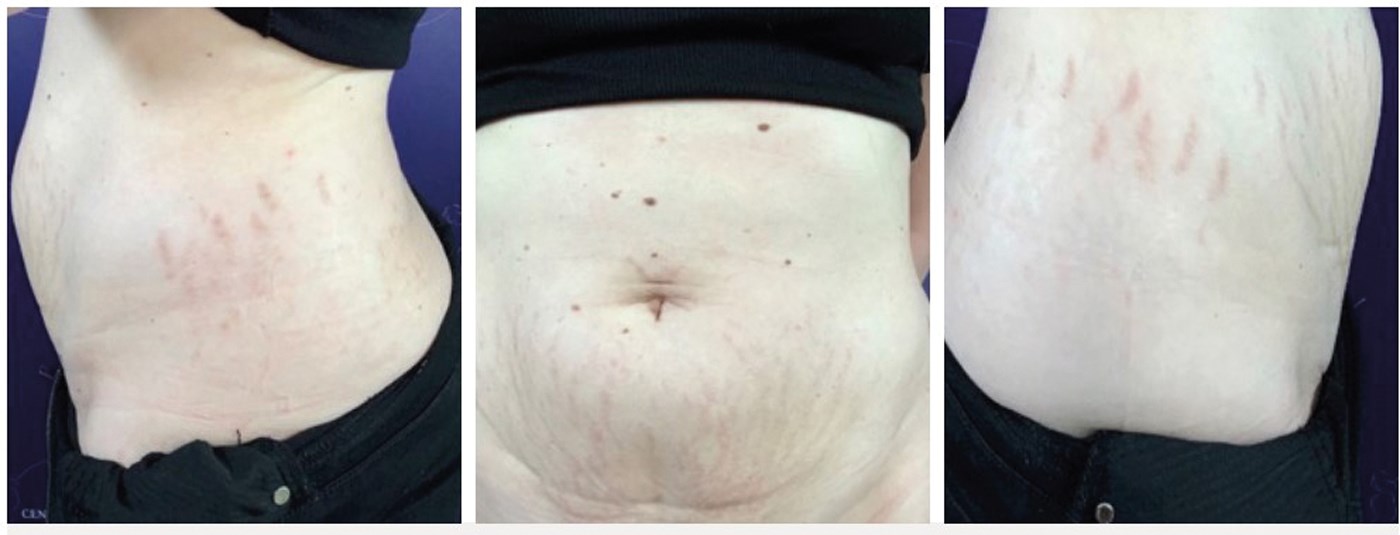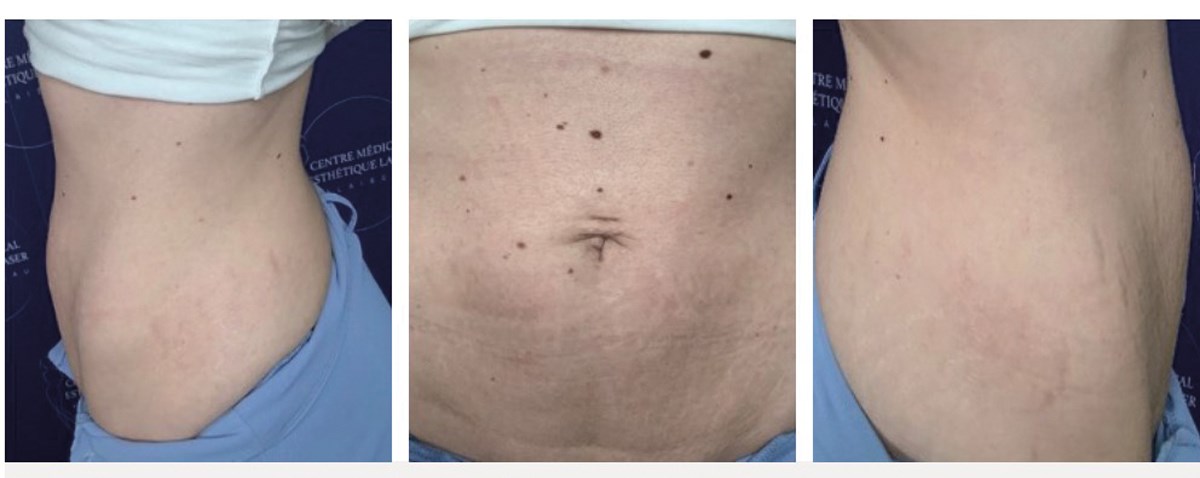Striae distensae, or stretch marks, are a common dermatologic condition caused by excessive mechanical stretching of the skin with damage to dermal elastic fibres [1]. The lesions are arranged perpendicular to the direction of skin tension.
Striae are often associated with rapid growth during adolescence, excessive weight gain and late stages of pregnancy [2,3]. It is also associated with some medications and medical conditions. Although striae are clinically benign, they can have a significant emotional impact, leading many affected individuals to seek treatment [5]. Early stretch marks are more amenable to treatment, however, there is no universally agreed upon treatment of striae distensae [4].

Before.

After two treatments.
Case report
A 35-year-old female presented to clinic with a history of striae distensae that occurred two years earlier during her first pregnancy. The patient attempted numerous preventative treatments both during her pregnancy and following delivery to treat her striae, with little effect. Striae rubrae were clearly visible on her abdomen and lateral flanks, or ‘love handles’.
It was decided to treat the area with Frax 1550™ laser (available on the Nordlys™ system from Candela) because it addresses deeper skin resurfacing needs with short downtime and minimal side-effects [6]. For the treating physician, it is an easily and accurately reproducible procedure.
The patient provided a signed consent to undergo treatment and permission to publish pre- and post-treatment photos. The first treatment session was planned to occur after two weeks. In the interim, the patient was advised to avoid sun exposure. A topical numbing cream was applied to the planned treatment area one hour prior to treatment. Based on the striae type, location and patient skin colour, the laser parameters were selected as: 39mj (770micron depth), 10mm scan width and four passes.
It should be noted that treatment settings can be altered based on patient response to an initial treatment. In the current case, the patient’s skin quality had improved, and it was decided to apply higher fluence for even better results.
The second treatment was performed one month later. The settings for the second session were four passes with 39mJ (780micron depth), 10mm scan width.
After both sessions, proper postoperative care was administered to help avoid complications. Following the treatment of striae distensae, post-treatment oedema and redness decreased in a matter of hours / days. The use of sunscreen is mandatory, and a repair cream was prescribed for skin dryness and peeling that might occur. The patient verbally conveyed her contentment with the procedure, expressing a heightened sense of confidence and an improved self-image. She has not reported any adverse events following the final treatment session.
Conclusion
This case study supports the use of Frax 1550™ for improving the appearance of striae distensae by stimulating neocollagenesis and elastic fibre synthesis. Repeated treatments may be an effective approach to improving the treatment of striae distensae. Randomised controlled trials are necessary to firmly establish the efficacy of Frax 1550™ for treating striae distensae.
References
1. Al-Himdani S, Ud-Din S, Gilmore S, Bayat A. Striae distensae: a comprehensive review and evidence-based evaluation of prophylaxis and treatment. Br J Dermatol 2014;170:527-47.
2. Elsedfy H. Striae distensae in adolescents: A mini review. Acta Biomed 2020;91:176-81.
3. Farahnik B, Park K, Kroumpouzos G, Murase J. Striae gravidarum: Risk factors, prevention, and management. Int J Womens Dermatol 2016;3:77-85.
4. Mendes N, Alves PJ, Barros M, et al. A narrative review of current striae treatments. Healthcare (Basel) 2022;10:2565.
5. Karhade K, Lawlor M, Chubb H, et al. Negative perceptions and emotional impact of striae gravidarum among pregnant women. Int J Womens Dermatol 2021;7:685-91.
6. Tidwell WJ, Green C, Jensen D, Ross EV. Clinical evaluation and in vivo analysis of the performance of a fractional infrared 1550 nm laser system for skin rejuvenation. J Cosmet Laser Ther 2018;20:360-3.
Declaration of competing interests: None declared.
COMMENTS ARE WELCOME






